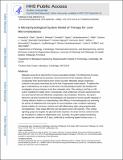A microphysiological system model of therapy for liver micrometastases
Author(s)
Clark, Amanda M.; Wheeler, Sarah E.; Taylor, Donald P.; Pillai, Venkateswaran C.; Young, Carissa L.; Prantil-Baun, Rachelle; Nguyen, Transon; Stolz, Donna B.; Borenstein, Jeffrey T.; Lauffenburger, Douglas A.; Venkataramanan, Raman; Griffith, Linda G.; Wells, Alan; ... Show more Show less
DownloadGriffith_A microphysiological.pdf (723.4Kb)
OPEN_ACCESS_POLICY
Open Access Policy
Creative Commons Attribution-Noncommercial-Share Alike
Terms of use
Metadata
Show full item recordAbstract
Metastasis accounts for almost 90% of cancer-associated mortality. The effectiveness of cancer therapeutics is limited by the protective microenvironment of the metastatic niche and consequently these disseminated tumors remain incurable. Metastatic disease progression continues to be poorly understood due to the lack of appropriate model systems. To address this gap in understanding, we propose an all-human microphysiological system that facilitates the investigation of cancer behavior in the liver metastatic niche. This existing LiverChip is a 3D-system modeling the hepatic niche; it incorporates a full complement of human parenchymal and non-parenchymal cells and effectively recapitulates micrometastases. Moreover, this system allows real-time monitoring of micrometastasis and assessment of human-specific signaling. It is being utilized to further our understanding of the efficacy of chemotherapeutics by examining the activity of established and novel agents on micrometastases under conditions replicating diurnal variations in hormones, nutrients and mild inflammatory states using programmable microdispensers. These inputs affect the cues that govern tumor cell responses. Three critical signaling groups are targeted: the glucose/insulin responses, the stress hormone cortisol and the gut microbiome in relation to inflammatory cues. Currently, the system sustains functioning hepatocytes for a minimum of 15 days; confirmed by monitoring hepatic function (urea, α-1-antitrypsin, fibrinogen, and cytochrome P450) and injury (AST and ALT). Breast cancer cell lines effectively integrate into the hepatic niche without detectable disruption to tissue, and preliminary evidence suggests growth attenuation amongst a subpopulation of breast cancer cells. xMAP technology combined with systems biology modeling are also employed to evaluate cellular crosstalk and illustrate communication networks in the early microenvironment of micrometastases. This model is anticipated to identify new therapeutic strategies for metastasis by elucidating the paracrine effects between the hepatic and metastatic cells, while concurrently evaluating agent efficacy for metastasis, metabolism and tolerability.
Date issued
2014-05Department
Massachusetts Institute of Technology. Department of Biological EngineeringJournal
Experimental Biology and Medicine
Publisher
Royal Society of Medicine
Citation
Clark, A. M., S. E. Wheeler, D. P. Taylor, V. C. Pillai, C. L. Young, R. Prantil-Baun, T. Nguyen, et al. “A Microphysiological System Model of Therapy for Liver Micrometastases.” Experimental Biology and Medicine 239, no. 9 (May 12, 2014): 1170–1179.
Version: Author's final manuscript
ISSN
1535-3702
1535-3699